June 4th, 2007
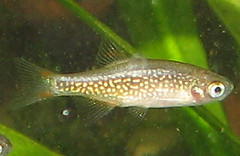 I just received my July 2007 issue of Tropical Fish Hobbyist this week, and was delighted to see that the cover article is about breeding the Celestial Pearl Danio, previously the Galaxy Rasbora. After all, I previously noted that this species, while just introduced to the hobby, is in danger of being over-fished and exterminated from its original habitat. Due to my own trouble breeding these guys, I eagerly looked inside to see what I was doing wrong. Apparently I missed the boat somewhere because they’re supposedly prolific egg scatterers, spawning almost daily in neutral to slightly alkaline water. But that wasn’t the thing that struck me.
I just received my July 2007 issue of Tropical Fish Hobbyist this week, and was delighted to see that the cover article is about breeding the Celestial Pearl Danio, previously the Galaxy Rasbora. After all, I previously noted that this species, while just introduced to the hobby, is in danger of being over-fished and exterminated from its original habitat. Due to my own trouble breeding these guys, I eagerly looked inside to see what I was doing wrong. Apparently I missed the boat somewhere because they’re supposedly prolific egg scatterers, spawning almost daily in neutral to slightly alkaline water. But that wasn’t the thing that struck me.
While reading the article, I was startled to read that the Celestial Pearl Danio apparently isn’t really in such dire straights as originally reported. The article uses the following reasoning why the reported crisis is nothing more than rumor:
- Collecting aquarium fish benefits local people, so they won’t over-fish because then their livelihoods are affected.
- Normally, when supply diminishes, price goes up. However, the wholesale price for the Celestial Pearl Danio has continued to drop.
- The fish have been found to originate from more than one pond, as was originally suspected, and it’s unknown how much more widespread they may be through their region.
- Since they’re such prolific egg layers, even if the adults were all fished from a pond, the eggs would hatch, and they’d make a comeback.
While this sounds like great news, all of this logics appears to be author speculation, fueled by the stated belief that they don’t want the aquarium hobby to be blamed for the destitution of a species. I’m delighted if this news is true, but for me, it’s going to take more convincing before I recommend that everyone go out and buy this fish. At the very least, I would encourage any potential buyer to ask questions of their fish store owners about the origins of the fish in their tanks. If the Celestial Pearl Danio, is as prolific a breeder as claimed, then fish farms should soon have a captive breed supply, leaving the original habitat unaffected.
Posted in General | 1 Comment »
May 25th, 2007
Unfortunately, it’s not mine! On Weds, I helped my friend and fellow GWAPA member upgrade his stand from a wire-frame stand to a much sturdier wood stand that he had built himself. This, all in preparation to hold, among others, his brand new and shiny ADA 90P tank. If you’ve never seen an ADA tank up close before, you’re missing out. Seamless design with expertly done silicon, without any messy silicon drips, even on the bottom of the tank. Plus, the glass itself is incredibly clear, and nicely polished on the edges. Yeah, I have tank envy!
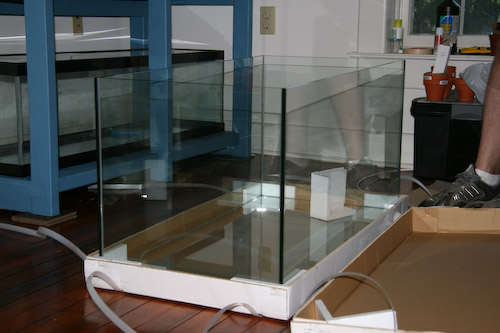
Before we could setup the tank, we had to get his new, nearly 7 foot, stand up a long flight of stairs and setup in his fish room. Besides the small obstacle that all of the ceilings in his apartment were not uniformly taller than 7 foot, we eventually got the stand upright, and in position. A few blocks and wedges later, and it was level and ready for tanks. Aaron proceeded to put down the padding he bought to cushion the tank, and cut it to size. With the tank now in place, I can’t wait to see how he scapes it. There’s one small caveat, he’s not using Aquasoil. He’s setting up an ADA tank with a soil substrate. Should be interesting…

Posted in General | Comments Off on Beautiful New Tank and Stand!
May 14th, 2007
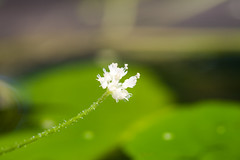 Over the winter, I kept a 10G aquarium chalked full of various plants I was hoping to transfer outdoors to my pond. One of these plants is Brazilian Pennywort. I’m hoping that it to grow immersed in the pond, and vine down the brick sides. So, I’ve been letting the Pennywort in the 10G tank grow out of the tank, and up onto the windowsill immediately above that tank. With some good Spring sunlight, I was pleased to find this lone flower stalk coming from one of the nodes. I’m guessing that this will turn into a seed cone like a sagittaria subulata flower stalk does. I transplanted this runner out to the pond this morning, so we’ll see if I get any more flowers popping up in the full sun.
Over the winter, I kept a 10G aquarium chalked full of various plants I was hoping to transfer outdoors to my pond. One of these plants is Brazilian Pennywort. I’m hoping that it to grow immersed in the pond, and vine down the brick sides. So, I’ve been letting the Pennywort in the 10G tank grow out of the tank, and up onto the windowsill immediately above that tank. With some good Spring sunlight, I was pleased to find this lone flower stalk coming from one of the nodes. I’m guessing that this will turn into a seed cone like a sagittaria subulata flower stalk does. I transplanted this runner out to the pond this morning, so we’ll see if I get any more flowers popping up in the full sun.

Posted in General | Comments Off on Pennywort Flower
April 29th, 2007
Last week I ordered a huge box of manzanita wood from manzanita.com to split between myself and the rest of GWAPA. I highly recommend this retailer for ordering wood for your aquarium. Rich, who I dealt with, is very professional and is willing to accomodate just about anything you’re looking for. I described to him that I wanted some branchy pieces, along with plenty of pieces that have lots of character.
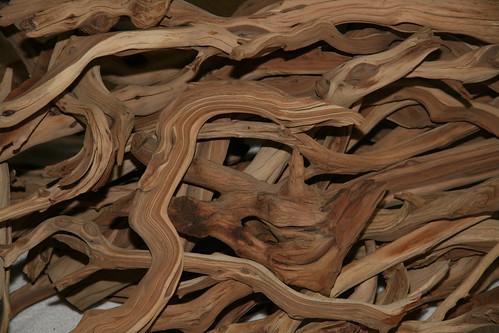
When I got home last Wednesday, on my doorstep was a box about 6 foot tall, and about 2 foot in diameter. Due to the size, it made 65lbs much more cumbersome than if it were in a more manageable size. I separated the box into three categories: branchy, large sized pieces, and medium sized pieces. From there, I divided the wood into a number of different lots that were pretty even. I took a few lots for myself, and the rest were auctioned off at the GWAPA meeting this weekend. Look for some upcoming tank pictures with this wood in it!
Posted in General | 16 Comments »
April 10th, 2007
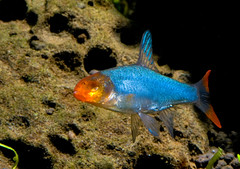 So often, all we tend to show off are our pristine looking aquariums, with algae-free leaves, and beautiful fish. I try and show those pictures (as few as they may be), but more than that, I like to share everything else along the way, even if it might be a little embarrassing or not quite perfect. Well, here is another such example. I decided to feature a few of my less-than-ideal fish today. I’m sure we’ve all had them. You get that perfect fish home from the fish store. You’re proud to show it off to your friends, and after a few years in your tank, you notice that once graceful fish has a spine that nears 90 degrees, and it just kind of hovers around the tank being unable to swim. Well, I have a couple of these situations.
So often, all we tend to show off are our pristine looking aquariums, with algae-free leaves, and beautiful fish. I try and show those pictures (as few as they may be), but more than that, I like to share everything else along the way, even if it might be a little embarrassing or not quite perfect. Well, here is another such example. I decided to feature a few of my less-than-ideal fish today. I’m sure we’ve all had them. You get that perfect fish home from the fish store. You’re proud to show it off to your friends, and after a few years in your tank, you notice that once graceful fish has a spine that nears 90 degrees, and it just kind of hovers around the tank being unable to swim. Well, I have a couple of these situations.
Case 1: Blind Fish
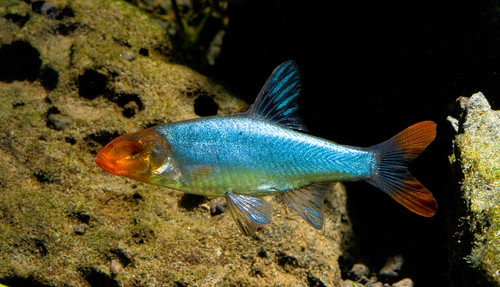
I don’t remember buying a fish without an eye, so this must have happened somewhere along the way. Presumably, the poor guy knocked his eye on a rock or piece of equipment, and wasn’t able to find it in time to have the ER sew it back on. Nevertheless, he’s an otherwise normal specimen that schools with the other fish, and seems happy.
Case 2: Siamese Endler
 It’s amazing how fast Endler’s breed. You start with a few pairs, and before you know it, you’re stuck with hundreds of these guys in your tanks. Mathematically speaking, you’re bound to see a few funny ones along the way. Well, here is the most bizarre one I’ve ever seen. This female was born perfectly healthy. As she grew up, I noticed a growth on the underside of her belly. As she continued to grow, so did the growth. Once it got larger, it was obvious that this wasn’t just a tumor of sorts, but another fish body altogether! Not only that, but there is an extra set of pelvic fins growing off of that body that she appears to be able to control. I’ve had her for at least 6 months, maybe a year, and she has shown no other abnormal behavior. Amazing!
It’s amazing how fast Endler’s breed. You start with a few pairs, and before you know it, you’re stuck with hundreds of these guys in your tanks. Mathematically speaking, you’re bound to see a few funny ones along the way. Well, here is the most bizarre one I’ve ever seen. This female was born perfectly healthy. As she grew up, I noticed a growth on the underside of her belly. As she continued to grow, so did the growth. Once it got larger, it was obvious that this wasn’t just a tumor of sorts, but another fish body altogether! Not only that, but there is an extra set of pelvic fins growing off of that body that she appears to be able to control. I’ve had her for at least 6 months, maybe a year, and she has shown no other abnormal behavior. Amazing!

So, I’ve shared some of my embarrassing fish. Please do the same via comments or email.
Posted in Fish Profiles, General | 5 Comments »
March 16th, 2007
 When your aquascape has a glosso foreground, just about every 6-8 weeks, you glosso will look like it does in this picture. The glosso will have formed a mat that’s about 3-4 inches thick, with portions of that mat floating up away from the substrate. Underneath the substrate, you’ll have a nice thick mess of mulm sitting there. And if you’re lucky, you’ll have from fry using this thick mat as a refuge from much larger fish.
When your aquascape has a glosso foreground, just about every 6-8 weeks, you glosso will look like it does in this picture. The glosso will have formed a mat that’s about 3-4 inches thick, with portions of that mat floating up away from the substrate. Underneath the substrate, you’ll have a nice thick mess of mulm sitting there. And if you’re lucky, you’ll have from fry using this thick mat as a refuge from much larger fish.
Too bad for those fry, when this happens, it’s time to replant! I have to do just this, this week. In about 6 weeks, I will be hosting the GWAPA meeting. Hopefully, by that time, that new glosso plantlets will have matured into a nice 1″ thick glosso mat.
Timing is one of the key things to keep in mind for every aquascape. Whether you’re planning to show the tank to friends, club members, or take that perfect photograph for sharing online or to submit in an aquascaping contest, timing is everything. I generally tend to play things by ear, but one of these days, I’ll spend a little more time counting backwards. What I mean by that, is the advice of another GWAPA member, Ghazanfar, who suggests writing down every time you trim a plant. Then, whenever that particular plant looks “perfect,” note that on your calendar too. If you subtract the “perfect” date from the date you trimmed, you should know exactly how long it takes for each group of plants in your tank to reach its ideal look. Then, anytime you want to show your tank, you just need to count backwards from that date for each plant, and trim accordingly. By the tank your friends are over, every plant in your tank should look “perfect!” (Of course, YMMV.)
Posted in 75G Tank Log, General | 1 Comment »
March 14th, 2007
 At the last GWAPA auction, “Delaware Jim” was auctioning off two bags of some “mutant anubias” that appeared in his tank. Apparently, he claims, this plant grew from a regular Anubias barterii ‘nana’ rhizome. What we’re talking about here, is an anubias plant with leaves that very closely resemble Anubias barterii ‘coffefolia,’ except the stems are approximately 12+ inches tall.
At the last GWAPA auction, “Delaware Jim” was auctioning off two bags of some “mutant anubias” that appeared in his tank. Apparently, he claims, this plant grew from a regular Anubias barterii ‘nana’ rhizome. What we’re talking about here, is an anubias plant with leaves that very closely resemble Anubias barterii ‘coffefolia,’ except the stems are approximately 12+ inches tall.
In the picture, you can see that some of the leaves are growing out of the water. This is in a 54G corner tank that is 24″ tall. That’s one heck of an anubias ‘nana!’ My theory is that some other species of anubias was hitching a ride with his nana plant, and over time, the plant grew to this incredible size. If that’s not the case, then something in his tank must have spurred this mutation. In either case, I promise that I won’t drink the water if I’m ever at Jim’s house!
Posted in General | Comments Off on Mutant Anubias!
March 5th, 2007
 This weekend, we made a trip down to New Bern, North Carolina to visit family. Since we were blessed with some beautiful 65 degree days, we decided to visit a park on the Neuse River where pine bogs and forest were all around. Of course, I couldn’t resist hiking through the surrounding areas to do some exploring and snap a few pictures.
This weekend, we made a trip down to New Bern, North Carolina to visit family. Since we were blessed with some beautiful 65 degree days, we decided to visit a park on the Neuse River where pine bogs and forest were all around. Of course, I couldn’t resist hiking through the surrounding areas to do some exploring and snap a few pictures.
 With pine needle litter everywhere, I can only imagine how soft the water must be here. As damp and marshy as this looks, there really was not an unpleasant smell whatsoever. This is why I believe this is a bog, as opposed to a swamp, where water sits, allowing organics to break down and release gases. The bog flowed directly into the Neuse River, where Cypress trees lined the water’s edge. Even despite the lack of summer leaves, the roots and water provided for a very nice landscape. I was hoping to find a few pitcher plants to photograph, but I imagine it is still too soon after the latest frost for
With pine needle litter everywhere, I can only imagine how soft the water must be here. As damp and marshy as this looks, there really was not an unpleasant smell whatsoever. This is why I believe this is a bog, as opposed to a swamp, where water sits, allowing organics to break down and release gases. The bog flowed directly into the Neuse River, where Cypress trees lined the water’s edge. Even despite the lack of summer leaves, the roots and water provided for a very nice landscape. I was hoping to find a few pitcher plants to photograph, but I imagine it is still too soon after the latest frost for

those. I did, however, see quite a few Hydrocotyle vines starting to emerge along the wet ground. I
bet the entire floor will soon be covered with these as the weather warms. One of the neat things about this specific location is that the Neuse River is brackish, so among the freshwater plants and species found in the bog, where the two met you could find more saltwater-related things of interest. There was plenty of barnacle-covered driftwood, mussels, and clam shells populating the sandy beach.
I hope to get back down to these bogs sometime later in the year when it’s warmer to see the contrast the seasons have on these areas. If anyone has any suggestions for places to go, please comment to let me know!
Posted in General | 2 Comments »
February 6th, 2007
This was posted on the forums, but I wanted to re-emphasize its importance. It appears that the native habitat of the Galaxy Rasbora is being threatened due to overfishing by exporters of the aquarium fish. I’m not really sure what we, as hobbiests, can do to help except to avoid buying Galaxy Rasboras that aren’t captive bred. Unfortunately, most LFS’ don’t know or display such information.
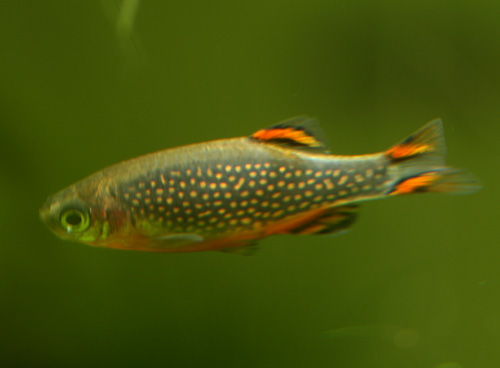
I’m a little bit conflicted because as I mentioned a few weeks ago, I recently purchased a bunch of these beautiful fish after coming across a deal I couldn’t refuse. I’ve been feeding them black-worms, so now I think I’m going to do my best to breed these guys. Unfortunately, there’s not a whole lot of information about their spawning parameters due to their newness to the hobby. Please comment if you know how to breed these fish.
Update: I manage to come across a link to another site that details how they’ve successfully bred the Galaxy Rasboras. Here’s the link: http://www.aquamoss.net/Articles/Microrasbora-sp-Galaxy.htm
Posted in Fish Profiles, General | 7 Comments »
January 19th, 2007
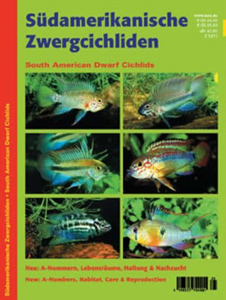 A few weeks ago, I came across this post on one of the cichlid forums, offering a dual language (English/German) version of a special DATZ publication on South American Dwarf Cichlids. I decided to contact the poster, Mike Wise, who consequently is the person who did the actual translation work from German to English, and is now selling copies of the book himself to folks in the United States.
A few weeks ago, I came across this post on one of the cichlid forums, offering a dual language (English/German) version of a special DATZ publication on South American Dwarf Cichlids. I decided to contact the poster, Mike Wise, who consequently is the person who did the actual translation work from German to English, and is now selling copies of the book himself to folks in the United States.
This week, I received the book, and boy am I impressed. This doesn’t have the extensive information that the Cichlid Atlases have on each species, but as a simple photo log for hundreds of apistogramma or other dwarf species, with general locality information, it’s tremendous. Most species have multiple photographs, showing possible color morphs, and noting differences between different A-numbers currently attributed to the same species name. The book is organized sequentially by A-number, but the index is very comprehensive, listing both Latin and common names for fish, so they’re easy to lookup.
My only complaint for this book is that it doesn’t list pH or TDS information for each species. That said, I realize that this information is not necessarily available for every species, and even if it were, might fluctuate greatly depending on the wet/dry season.
All in all, this is a very dangerous book. It’s easy to flip through the pictures, and find some amazing species that you would like to try in your tank. I imagine many of these are hard or impossible to find unless you go collect them yourself, but it’s great to peruse nonetheless.
You can get a sample of some of the book’s pages here.
Posted in Books, General | 3 Comments »
 I just received my July 2007 issue of Tropical Fish Hobbyist this week, and was delighted to see that the cover article is about breeding the Celestial Pearl Danio, previously the Galaxy Rasbora. After all, I previously noted that this species, while just introduced to the hobby, is in danger of being over-fished and exterminated from its original habitat. Due to my own trouble breeding these guys, I eagerly looked inside to see what I was doing wrong. Apparently I missed the boat somewhere because they’re supposedly prolific egg scatterers, spawning almost daily in neutral to slightly alkaline water. But that wasn’t the thing that struck me.
I just received my July 2007 issue of Tropical Fish Hobbyist this week, and was delighted to see that the cover article is about breeding the Celestial Pearl Danio, previously the Galaxy Rasbora. After all, I previously noted that this species, while just introduced to the hobby, is in danger of being over-fished and exterminated from its original habitat. Due to my own trouble breeding these guys, I eagerly looked inside to see what I was doing wrong. Apparently I missed the boat somewhere because they’re supposedly prolific egg scatterers, spawning almost daily in neutral to slightly alkaline water. But that wasn’t the thing that struck me.








 When your aquascape has a glosso foreground, just about every 6-8 weeks, you glosso will look like it does in this picture. The glosso will have formed a mat that’s about 3-4 inches thick, with portions of that mat floating up away from the substrate. Underneath the substrate, you’ll have a nice thick mess of mulm sitting there. And if you’re lucky, you’ll have from fry using this thick mat as a refuge from much larger fish.
When your aquascape has a glosso foreground, just about every 6-8 weeks, you glosso will look like it does in this picture. The glosso will have formed a mat that’s about 3-4 inches thick, with portions of that mat floating up away from the substrate. Underneath the substrate, you’ll have a nice thick mess of mulm sitting there. And if you’re lucky, you’ll have from fry using this thick mat as a refuge from much larger fish. At the last GWAPA auction, “Delaware Jim” was auctioning off two bags of some “mutant anubias” that appeared in his tank. Apparently, he claims, this plant grew from a regular Anubias barterii ‘nana’ rhizome. What we’re talking about here, is an anubias plant with leaves that very closely resemble Anubias barterii ‘coffefolia,’ except the stems are approximately 12+ inches tall.
At the last GWAPA auction, “Delaware Jim” was auctioning off two bags of some “mutant anubias” that appeared in his tank. Apparently, he claims, this plant grew from a regular Anubias barterii ‘nana’ rhizome. What we’re talking about here, is an anubias plant with leaves that very closely resemble Anubias barterii ‘coffefolia,’ except the stems are approximately 12+ inches tall.




